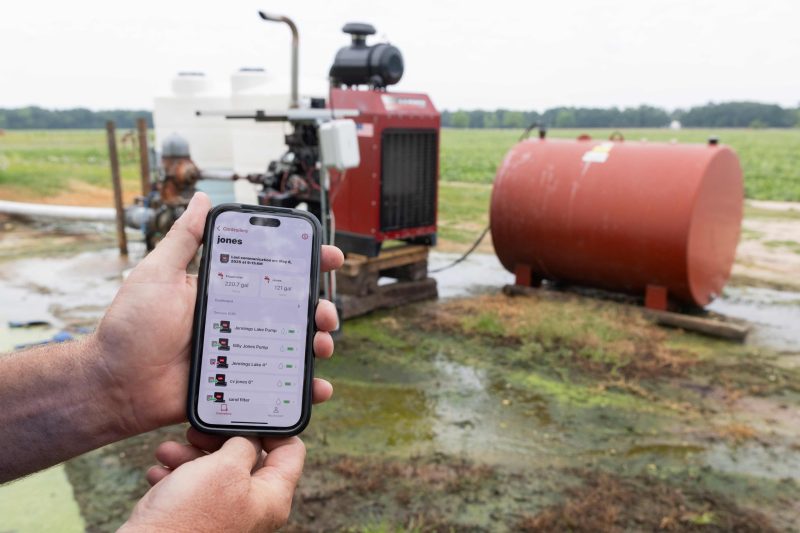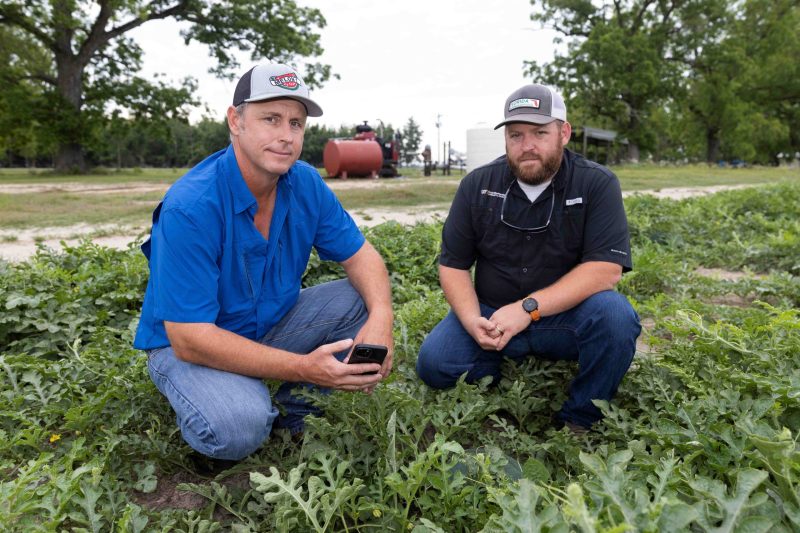
A UF/IFAS assessment of nine Suwannee Valley growers farming 1,883 acres of watermelon revealed they saved a combined 164 million gallons of water last year thanks to irrigation automation. Credit: Tyler Pittman, UF/IFAS
Megan Winslow, Public Relations Specialist, UF/IFAS Communications
May is peak watermelon season in North Florida, and farmers are busy tending to their crops as they anticipate harvesting around Memorial Day. Rather than painstakingly twisting water valves, however, an ever-growing number are relying on automated irrigation, and the collective impact is profound. A UF/IFAS assessment of nine Suwannee Valley growers farming 1,883 acres of watermelon revealed they saved a combined 164 million gallons of water last year thanks to automation.
“We’re flirting with saving more than 696 million gallons of water each year if the farmers of all 8,000 acres of watermelon in the region adopt this technology,” said Tyler Pittman, the UF/IFAS agriculture and natural resources agent who conducted the assessment. Supported by grants from the Florida Department of Agriculture and Consumer Services (FDACS), Pittman has spearheaded a years-long campaign to educate Suwannee Valley farmers about the benefits of automation. His efforts include 110 acres of demonstration sites, Extension programming attended by hundreds of people and personal consultations with farmers curious about the technology.
Irrigation management is paramount to commercial watermelon production. UF/IFAS recommends short, frequent irrigation to maximize plant absorption and minimize water and nutrient leaching, but conventional systems require travel between fields to manually activate and deactivate valves. Wireless automation equipment allows growers to fine-tune their outputs and to schedule and control them remotely using smartphone apps.
“Farmers can irrigate their fields while sitting on a beach on an island somewhere,” Pittman said. “All they need is an internet connection.” Eighty-nine percent of the farmers Pittman surveyed said automation has helped them save time. On average, they reported 1.7 fewer hours spent in the field each day.
Automation helped all surveyed farmers use less water. On average, they reduced their irrigation run times by 1.4 hours a day. Adam Whitehurst, who grows watermelon in Alachua and Levy counties, purchased automation equipment to try to boost efficiency. “The system allows me to monitor fertilizer run times and measure exactly how much I put out,” Whitehurst said. “The crop just grows better.”

Smartphone apps allow farmers to easily control their automated irrigation systems. (Tyler Jones, UF/IFAS)
–
Cost-share programs are a powerful incentive for farmers to invest in automation systems, which can run between $10,000 and $20,000 per field. Two-thirds of the farmers Pittman surveyed said they would not have made a purchase without assistance from programs like those offered by the FDACS Office of Agricultural Water Policy and the Suwannee River Water Management District. More than half of the farmers received more than $10,000 to buy their equipment.
“If it wasn’t for cost share, there’s no way I would have thought about trying automation,” said Garrett Beach, a watermelon farmer in Gilchrist County. Beach automated the irrigation of 600 acres of watermelon in 2023. He was initially nervous about relying on the system. For weeks, he insisted on manually operating it by flipping a toggle switch. “Now, I trust it, and I see its value,” Beach said. “I won’t farm without it from now on.”

Gilchrist County watermelon farmer Garrett Beach, left, and Tyler Pittman, UF/IFAS agriculture and natural resources agent. (Tyler Jones, UF/IFAS)
- Where Did That Weed Come From? The Importance of Weed Management Practices and Timings - December 5, 2025
- Sustainable U.S. Peanuts Kicks Off 2025 Crop Enrollment - December 5, 2025
- Grant Opportunity Available to Attend American Forage & Grassland Council Conference, Ashville – January 12-15 - December 5, 2025
